
|
 |

|
 |
Watching a performance through my camera is like meditation: Avinash Pasricha - Shveta & Anoop Arora e-mail: shwetananoop@gmail.com Photos: İAvinash Pasricha March 15, 2019 I am brought back to the same vision - a beautiful dancer on the stage, presenting abhinaya as the lovelorn heroine, and then nritta with several movements and chakkars. But your memory cannot retain these visions to be seen later by you or your friends. Words alone would not be able to describe the moment, and that particular movement. And so click, click, click goes the camera, and all is preserved for posterity. Many a time, in trying to explain a movement, I have to consult my husband, who's a photographer, and he can show me the exact picture. And at times, multiple images of the same movement, which are clicked every fraction of a second, capture almost every aspect of the movement. I think my article would be incomplete without the pictures. Here, I am profiling a person whom I've met at several performances in the past few years. In almost every performance in Delhi, he is there with his wife Santosh, sitting among the front row audience. This unassuming person is the legendary photographer Avinash Pasricha, who has worked extensively with many dancers and dance forms for over half a century. His contribution to dance is unparalleled. My husband and I interviewed him together, since there were technical aspects of photography that the two could discuss better. An earlier interview of Avinash Pasricha published on Narthaki.com, for those who want a better understanding of his journey and profile. When you started dance photography, how difficult was it to take action pictures in dim light, without DSLRs? Initially, in the cameras we used BW film 400 ASA Tri-x. If you were using a normal lens, it could open up to f1.4, we would click at f2. In those times, there was not so much stage photography, though. Video cameramen would come with their sun guns. The people holding sun guns would run in front of you and block your view. I started dance photography in 1966. At that time, there was a new developer, Acufine, that would push the Tri-x from 400 to 1200 ASA. Photographers usually used flash on the camera, but that was the acceptable form. Initially, I started photography with flash guns on my Rolleiflex using flash bulbs. You had to be very careful while clicking because you used a bulb each time. When I joined SPAN, my first dance assignment was shooting Indrani Rehman. This was meant for the cover story. This was in the late '60s. The issue was planned for some time in the next year - issues were planned months in advance. Sapru House was booked. We took a flash; we took a 120 camera, 35 mm was not so popular. But it went wrong - the Ektachrome film became all green in the processing. In Bombay, there was Dheeraj Chawla, the main photographer of Illustrated Weekly. He had photos which we used on the cover, and mine were used inside, smaller, in black and white. We used to have flash on the camera, which I gave up mainly in 1966, when we started using Acufine. There was a festival conducted by the Gandharva Mahavidyalaya called Vishnu Digambar Jayanti, which I covered very well. Those days, interestingly, I had no ear for music. A cousin was connected to the Mahavidyalaya, and he dragged me along. In Sapru House, I kept sitting with my camera right near the stage, uncaring of the audience, the music and the artiste, clicking. Those are some of my best mood pictures of music. Naturally, the contact with the Mahavidyalaya led to pictures of dance. I photographed Madhavi Mudgal, who was an upcoming dancer in those days. In the early '70s, ITDC wanted a dance poster, so I took Durgalal and Madhavi - doing Kathak - to the Ashoka Hotel convention hall. You get ideas - I put the camera on a tripod and got Madhavi to move, and Durgalal to sit, so I captured a blur. And that was a famous picture of a dancer twirling around Durgalal. 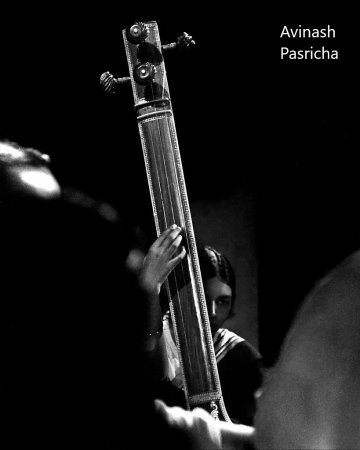 Tanpura (1966) 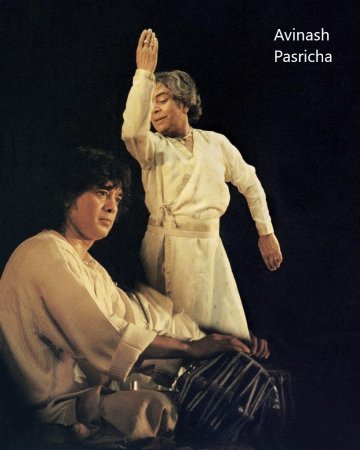 Zakir Hussain and Pt Birju Maharaj The basic thing about any photography is the photographer's mind first - the urge to create something different, new. In those days, I was very fond of multiples. Dance is movement. Why should it be a static picture? It should have a blur or at least two or three movements in the same picture. In those days, Nikon cameras did not have multiple exposure possibilities. It had to be created - I did a lot of multiples on my camera that way. Unfortunately, all the digital cameras I've had so far did not have multiple exposure. Everything is done in Photoshop these days, although I would prefer to shoot multiples. Several photographers are shooting multiples and doing a good job of it. Now, I look at dance more for pleasure than photography. I take the camera only for one purpose - meditation, focus, attention. The mind does not wander. I do not have control over the light on stage, it's uneven and varied, so you have to constantly change either the ISO or the shutter speed. Aperture is mostly full setting. That's the story of how my photography has gone on and will continue. I continue to carry my camera and was shooting music last night, at a VSK baithak of Bharathi Prathap at WWF. I now use a very lightweight camera, my hand won't take the big long lens, and I can't carry a big bag either. My biggest problem with digital cameras - there's a slight gap between the click and the recording. So half the time, you either anticipate the click or miss it, then delete it, no problem. But you tend to overclick always. I've noticed that if you watch a one-hour program, you sit for two hours on the computer to edit the next day! Do you ever get to influence the lights or do you have no feedback on the lighting? I have no control over the stage lighting, unless I'm shooting with my lights, which I've done occasionally either in my studio or on stage with my strobe lights. But nowadays, the lightman - whatever he does he does, smoke and dim lighting... some lightmen enjoy fiddling with the lights unnecessarily. Sometimes the dancer is doing bhava and the lights above her are dimmed, so her eyes are in darkness. What can you do? The light is overhead, the eyes are in shadow. You have no choice. So you either don't take the picture and give up or do the best you can. Yet, ultimately, the 'eye', the 'look' of the photographer are the most important - it's constantly looking at light, action, expression, and when you look at dance, you look at how much of the dance is coming through the face, expression and eyes. Poses are there, but they are secondary to my looking and the expression and eyes. If there is expression in the eyes, there is meaning, otherwise it is just a static pose. That's not a bad thing, but not enough for me. Which do you prefer - older cameras or digital ones? Both have their pros and cons. With the film cameras, the advantage, to a degree, was that you were more careful with your shooting. How many films could you click - two, maximum three, which is a hundred exposures? With digital, usually, 250-300 pictures is normal. Even 400. Sometimes, we don't click because of the time it's going to take in editing later. Even now, I cannot delete too much - unfortunately, you tend to keep more than you need. Then computer storage becomes an issue. 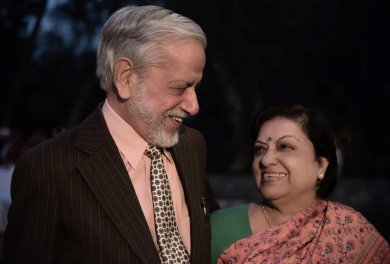 Avinash with wife Santosh (Photo: Prasad Siddhanti) Let me first talk about photojournalism. When you go out with a writer to do a story on a project, person or personality, you're looking for how that picture might be used in the magazine; you don't click randomly. First, you understand what the essence of this place is, then you look around and take your pictures. You have to be quick because the writer will carry all the material home and write later, but you have to think on the spot. Many pictures have to be clicked based on how they will be used. Secondly, what will tell the story, since you're hearing what this is all about. Let's say you're covering a family planning doctor in a group, so you make her use a loop, she's showing it - you're constantly aware that this will produce a picture and will be used. These are choices you make. Sometimes, there's nothing there, which is very difficult. Sometimes the writer will have to do his work, but I can't take a picture that will show that subject. For example, I was shooting once at Bokaro Steel. I climbed up a place to get the blast furnaces from that angle. This was for SAIL Authority. I was brought down because of safety reasons. Okay. They said we will take you to a place two km away where we've done R&D work - they're always very conscious of that. They had made a mixture of oil that reduces the wear and tear on the drum. So I asked, what should I click? Can you show both - the wear and tear, and this? No, they said, our mixer is this dowdy tank, please click. Our work is done, they said - but mine was not. So I said, you've wasted two hours of my time going there. That's typical of what happens. Now, coming back to dance, when the dancer comes to the studio, that is a bigger challenge. Because the guru comes, she is watching the pose. And the dancer will keep striking a pose like a statue, not like a dancer. It still happens every single time in a studio shoot, whether they're grown up or youngsters. Sometimes the youngsters are better - 10, 12, 15, they are more ebullient to dance. But the older ones who want to be more correct in front of the guru, they remain standing in a pose. Now what do I do? How do I get dance to show as dance? They also want full-length. And I want expression on the face. I can create mood with light and composition. But if I don't get the expression, what can I do with the lights? And a studio has standard lighting - three or four-light set-up. The only recourse is to do two things - look here...look there - you quickly get them to get involved in what you're saying, and you sometimes get to capture expressions because of them having to do something, rather than just hold the pose. And that is still the effort - to get expressions - and you keep trying. With digital, the advantage is that you can click more. But even if you give them mood pictures, they will be wasted - they use only full-length in brochures, they don't understand the mood you have tried to capture. Capturing mood is a different kind of photography. In live dance... It depends on the dance form. Some lend themselves to good movement, like Kathak. Other dance forms don't have that much movement. Then, unfortunately, nowadays we are stuck with modernized costumes. In Bharatanatyam, for example, the fan used to look good, now there may be a baggy look in some new kinds of costumes. The fan shaped the dance form and the movement, which may not be visible now. But they're bored with the costume and they want to try something new, okay. Visually, I can do nothing about it. So what do I do? I would look for expressions on the face and forget the bottom half. One or two full-length, but mostly face and hands. Nowadays, it's interesting that people who promote their own pictures tend to promote the face for the posters. In full-length pictures, they get lost. Like you said, you knew nothing about dance and music when you began. After so many years now, how much does your perception contribute to the pictures? Honestly? I don't understand dance. My wife comes with me, she hears and watches the stories, but I don't know what is being depicted. The only story I keep seeing repeatedly is the dice game in the Mahabharata. Everyone, solo and group, are doing that. And you get bored with the same thing in all the forms. So I stopped shooting throw of dice. I put my camera away and wait for the dancer to finish it and go on to the next item. As I keep repeating, the bhava comes only in the top half and in the eyes. If the lighting is bad, then you can't get it, but if the lighting is okay, then... depends where your seat is, but I don't like moving around anymore. I choose one seat and get the best pics I can. But there are photographers jumping all over the place. Yesterday, there was a photographer who told me that he had clicked 400 pictures. I told him to show me the best 10. He could not. They don't have time to sift through their own pictures. Inni Singh is doing a good job. He shoots from afar with a long lens without disturbing the performance much. His portraits of the performers in the studio have also come out well. Each one has their own eye and vision, and that's what makes you a photographer - the ability to look and capture. He uses expensive cameras to capture the moment. Mine is inexpensive and so I have to anticipate the moment - click a second before. With digital, it doesn't matter so much - it will recur. And then you also notice movement patterns, since you've seen so much dance. That's why I don't follow the story so much also. If someone asks me to show a particular movement, I don't know which is which! You can't do both. In many cases, often, the story is not depicted in a particular moment in the dance. It can be depicted in motion in a video. Like you said, you should have an eye and a perception for the dance. I often put away my camera if it's a group - three dancers doing exactly the same thing is not more interesting than one. I prefer one dancer doing bhava than three dancers doing synchronized movement. That doesn't make a picture for me. Often, a sync picture can be made from the side with a long lens, which could compress them and make them look good. 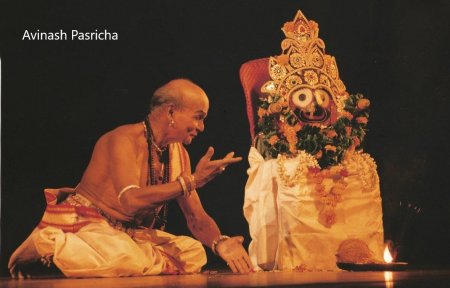 Kelucharan Mohapatra
Do you have any favourite form or dancer? Interestingly, the most 'unphotogenic' dancer I've loved photographing is Kelucharan Mohapatra. He was not good looking, but his full body stances and expression were better than any female Odissi dancer's. Birju Maharaj, also, at times - no looks, no body, but that expression! Or Kalamandalam Krishnan Nair - without makeup he could do amazing expressions. Sonal Mansingh does a variety of things; she particularly enjoys the naina stories, and you try to capture those eyes. Vyjayanthimala - she's fully involved in her dance and does it very well, even at this age. I've clicked Madhavi Mudgal a lot, but she doesn't let go. She's very proper. Her niece is also photogenic and fully involved. I enjoyed photographing Leela Samson, when she used to dance solo. When they both danced together, Leela photographed better. Malavika Sarukkai was stiff earlier, but has come through with her experimentation. Alarmel Valli dances like a gazelle. As for form, I have no favourite as such, I shoot them all. 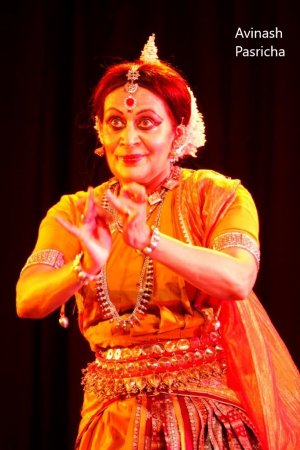 Sonal Mansingh
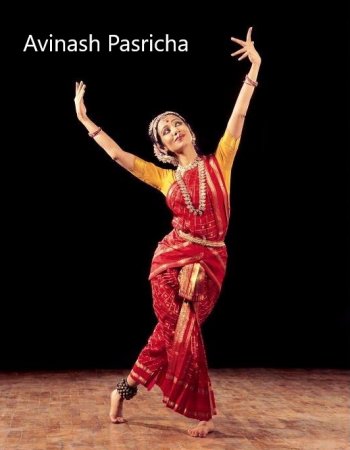 Alarmel Valli (1997) 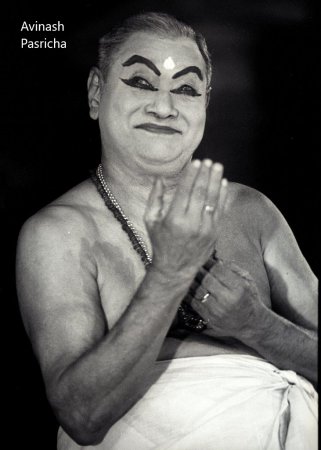 Kalamandalam Krishnan Nair Yes, now they think they need the photography! What do you think of mobiles being used for photography and videography at dance performances? Basically, I want to enjoy my toy more than what's on stage. My wife gets very upset, but how many people can you say no to? Then they start taking videos. I can see on the screen it's bad, but there's nothing to be done for it. And it's going to go up - so many camera phones being advertised as cameras more than as phones. And some of them are better than my SLRs in capturing in poor light. Some of my friends who have better cameras have even downloaded apps to improve the quality. I don't have a cell phone camera yet, my wife has an iPhone camera, but she doesn't use it, she has a photographer with her all the time! Your wife is always with you. What's her contribution to this process? Santosh: He's complaining all the time about no contribution from me. Avinash: She doesn't look at the photos I shoot! The archival work you're doing - did someone suggest it to you? My son Amit, who is also a photographer is the one who's been pushing me to do it. I'm not doing much. We've had young ladies who've come in and taken away all the negatives and done low-res scanning. We had a girl last January - these are young people coming out of Jamia and Aurobindo and being trained, in a way, to do photography and see this. They come to me twice a week or so to look at those scanned images and choose which have to be made into high-res scans, and which can be used later for a book or exhibition etc. But it's difficult and most of them have come and gone. The problem we will face is that the negatives are not that difficult to scan because they are numbered year-wise. But I, unfortunately, did not think about that in my transparencies. Transparencies come in two forms - some of them would go to Kodak for processing and be mounted slides or be mounted by Mahatta or wherever. Others were kept in strip form. They've been scanned also, but there was again no numbering, so it's become a problem. I had a diary for the negatives year-wise, and that was started around '66, not before that. Before that there aren't many anyway. I had an assistant who's now a photographer, Ashwani Chopra. Filing is difficult, I'm getting old now, not much energy left to do it. Amit is pushing me, but I don't think I can do it. Twice, SNA proposed an exhibition in Lalit Kala. But, nothing has happened so far! I don't chase them. I don't have the energy or the budget or the desire to put up an exhibition on my own. Any favourites from your archived photos? My most award-winning picture - it won a Wills Made For Each Other contest and won a prize of Rs 30,000 in the '80s. The tax bracket at that time for it was 97%, and they wanted to take away all that, but the income tax officer said no, it's a one-time thing, so he passed it. Then the case was opened again, and hung for 10 years, and then they said give 30%. Kelu babu had gotten dressed up for this. This wasn't a stage, it was a cloth on a platform, and there were no strobe lights, only sun guns, that's why the movement has been captured better. I clicked one roll. The winning photo was colour, but the agency lost it. This black and white is similar and better. I almost fell off at the Khajuraho temple while clicking a picture of Malavika Sarukkai. I was moving back from the temple and suddenly realized that there was no place to put the next step backwards. Then Yamini (Krishnamurthi) was to perform in Triveni and got ready early. She called me up to say that she had half an hour. I shot almost three rolls and got some of the best pictures. They are almost landmark pictures, in her yellow costume. She was very good at projecting different poses one after the other. 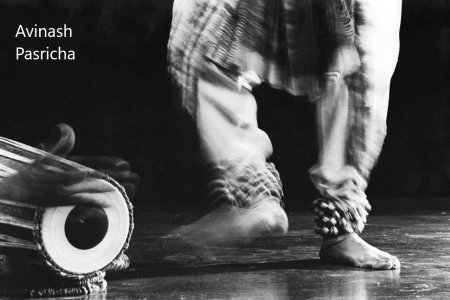 Made For Each Other Prize winning pix 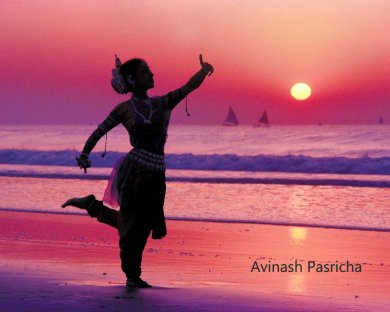 Madhavi Mudgal Working with the Dhananjayans, Navtej Singh Johar, Priyadarsini Govind and Geeta Chandran has been a joy. With Madhavi Mudgal, we made an audio visual way back in the '80s. The idea was to show eye expressions and mudras which most people miss in a large auditorium. Her expressions were very good. Then once, I had to take a picture at sunrise, so we all stayed the night before at Konark. But Madhavi could not get ready before sunrise and then we left for Puri. But the next day, at sunrise in Konark, we got some of the best shots. It is indeed a lot of work and grit... You have done so much work and compiled so many photographs. With your archives before you, it's like a baby and you've seen it grow. Do you still feel like doing it? Do you feel complacent? It gives me something to do . If I go to a performance without a camera, my mind wanders. It is like meditation. If you sit to do meditation, your mind wanders. It is the same with me. If I sit with my camera to see a performance, I am continuously focused on the dancer doing something. Even when the singer or musician starts singing, you have to wait till they move their hands. Unfortunately, the mics come in front of the performers and instruments and the surmandal. Then I have to sometimes go and stand in the wings. And that too, I wait for the drut laya, that means almost 30 to 45 minutes after the aalap. That way, neither the singer nor the audience are disturbed. Your work has been recognised and awards have come your way. The baby has come of age. What is the gratification, you think? You don't work for recognition, but if it comes your way, it makes you feel good. I got the SNA award and then Natya Vriksha gave me an award on World Dance Day 2018. Santosh: The first award he got was the Sahitya Kala Parishad Award way back in 1988. He was not there to receive it and I went on his behalf to receive it from Surendra Mathur. It is not even mentioned in his biodata! Post your comments Unless you wish to remain anonymous, please provide your name and email id when you use the Anonymous profile in the blog to post a comment. All appropriate comments posted with name & email id in the blog will also be featured in the site. |